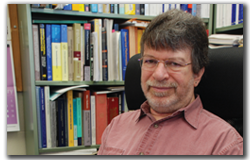|
AMNON “AJ” MEIR Meir explores complex-coupled phenomena Amnon “AJ” Meir, professor of mathematics, has a strong research interest in numerical and computational mathematics. Specifically, he conducts research in numerical partial differential equations, or the numerical analysis of methods for approximating solutions of partial differential equations, and the modeling and simulation of complex-coupled problems. He has several ongoing projects concerning problems that are considered complex- coupled phenomena. These involve mathematical models of physical systems, or physically motivated problems, which are governed by partial differential equations and involve multiple components, complex physics or multi-physics, as well as complex or coupled domains, or multiple scales. For example, Meir is working on poromechanics research in collaboration with Lorraine Wolf and Ming-Kuo Lee, both professors in the Department of Geology and Geography. The research is partially funded by the National Science Foundation and the U.S. Geological Survey. “Poromechanics is the mechanics of porous media and, in particular, the mechanical behavior or swelling and shrinking of fluid-saturated porous media,” said Meir. “My goal for the project is to analytically and numerically study various models of poromechanics and electro-poromechanics, to derive and analyze efficient numerical algorithms, and to develop computer programs to approximate solutions of the corresponding partial differential equations. In geophysics, computer models can be used to predict the ground’s stress, strain, and pore-pressure evolution related to earthquake faulting.” Meir also had funding from the National Science Foundation and the Department of Energy to study magnetohydrodynamics, which is the theory of the macroscopic interaction of electrically conducting fluids with a magnetic field. “For example, there are problems in metallurgy where you have liquid metals (molten metal), or in materials science, molten silicon, which is used to make computer chips. These conduct electricity and can be confined, shaped, and processed using magnetic fields. I am studying the equations to find efficient ways to conduct simulation of these effects.” Meir is also actively developing numerical methods for approximating solutions of partial differential equations that are posed on surfaces. “Many of the phenomenon posed on the surface of the earth can be modeled using partial differential equations,” said Meir. “In biological systems, you can also model observed pattern formations on a surface using partial differential equations. For example, we want to understand why a fish (or other animal’s) skin forms certain patterns. As such, this work has potential applications in the areas of developmental biology, cancer research, wound healing, tissue regeneration, and cell motility, among others.” Lastly, Meir is using his expertise to examine the mathematical and computational modeling of woven fabrics and three-dimensional interlaced structures. This research endeavor is partially supported by Auburn’s Office of the Vice President for Research and is in conjunction with Yanzhao Cao, professor in the Department of Mathematics and Statistics, and Sabit Adanur, professor in the Department of Polymer and Fiber Engineering. “Our goal is to develop new methodologies and paradigms for simulation of 3D- interlaced fibrous material systems and structures and for property and performance analysis and evaluation,” Meir said. “These structures are essential in a variety of engineering application areas such as automotive engineering, civil engineering, safety and protection, biomedical engineering, composites, filtration, pulp and paper engineering, and military and defense. We want to create tools that will allow engineers to simulate novel fibrous structures in virtual reality, and to study the effects of process parameters on the basic underlying fabric structure. These tools will enable the prediction of the performance of fabric structures and their optimization, and will allow simulation of the complex deformations of fabrics in actual applications.” |
About Meir AJ Meir received a bachelor of science in aeronautical engineering from Technion – Israel Institute of Technology, and a doctorate in mathematics from Carnegie Mellon University. “The engineering program in Israel was really theoretical, and I was interested in fluid mechanics, so the change from engineering to mathematics was not very big,” explained Meir. In addition to his current projects, Meir has consistently received “I saw a book about the connection between math and games and puzzles, and I think there is a lot to that,” said Meir, who has mechanical puzzles scattered throughout his office. “I like puzzles; the game and the challenge of solving a puzzle makes it fun; this is similar to solving a mathematics problem, which I really enjoy.” During the next academic year, Meir will server as a program director (in Computational Math) at the National Science Foundation, Division of Mathematical Sciences. For more information on Meir, visit wp.auburn.edu/ajm/. |

